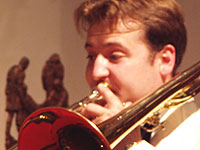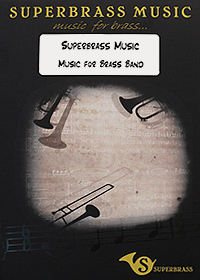Besson 1000 Tenor Trombone
1-Apr-2005We asked Jonathan Pippen to have an extended look at the Besson 1000 tenor trombone - the entry level model for aspiring young players, and see what he thought about it. Here's his verdict.
 It is always difficult to impartially judge and review an instrument that was not developed for its characteristics as a musical vehicle, but rather to be a financially viable option for purchase by, or for beginner players.
It is always difficult to impartially judge and review an instrument that was not developed for its characteristics as a musical vehicle, but rather to be a financially viable option for purchase by, or for beginner players.
Although it would be impossible and non-constructive for me to not comment on the instruments playing features and qualities (or lack of), I have tried to bare in mind that this instrument would not generally be considered for use by a professional or even advanced musician, but would be used by a novice from beginner to about grade 6 standard.
Besson need no introduction as a manufacturer of brass instruments and they have been making trombones for many years. However, unlike the brass band instruments that were supported by the banding community of the UK the trombone playing market was slightly different. At the end of the 60's and 70's the majority of the trombone playing pedigree of the UK (Arthur Wilson, Denis Wick, etc) began to play on imported instruments, most notably from America. This dominance of American instruments still exists in the world of the professional trombone playing, although British manufactures including Besson, are beginning to make a dent in this US dominance.
Unsurprisingly the intermediate trombone market followed suit, and the peripatetic rooms up and down the country are full of American and Japanese student model trombones. Not dissimilar to the Motorcycle industry of the early 80's, Kawasaki could produce a quality product, on a fast production line for less money.
Refreshingly it seems that Besson are determined to take back what should be rightfully theirs: the market for intermediate instruments in the U.K.
Brass instruments are designed with ease of playability and sound quality as principal. We demand these unreservedly, although in reality to find both is rare and undoubtedly expensive.
With this in mind it seems we are looking for much from an instrument that can't cost more than £400 off the shelf. Quite a Challenge!!!
Build Quality:
A student instrument often suffers from a cheap feel due to inexpensive material and post moulding treatment. This is amplified for the trombone as the inner slide action can betray a budget-plating job in seconds! For the inner slide you will find the platers material of choice is Nickel for its hardness and durability. (Similar to inner to valve plating). This is the material with which the inner slide is plated and will mean a longer life for the slide. For this instrument, the quality is good, and a lot of thought has gone into the selection of materials and with the quality used.
The outer slide is light and the action is smooth. The bottom bend is reinforced to help avoid denting, whilst the water key has a large screw head, which means no searching for that tiny screwdriver you can never find! You could actually turn this one by hand for a quick fix. The slide lock is external and turns freely and won't slip. This is much better than the internal lock used on the old Sovereign, which after some use would produce a really annoying click.
The bell section has a solid feel and is very similar in dimension to a professional model. (Some Japanese budget manufactures squeeze the bell section together making it long and thin!! yuk). The bell its self is 8 inches giving the feeling of a medium large instrument and the round Besson counter balance gives a sense of quality. The bell material is quite thick adding to the weight of the instrument but increasing damage resistance. This also means that the instrument playing characteristics are affected, making the sound a little warmer, and for an instrument aimed at this market, that really impressed.
22 POINTS
Intonation:
As any trombone player worth his/her salt will know the intonation of an instrument is down to the player rather than the instrument. The physics of any brass instrument dictates that there are differences in the intonation of the harmonic columns, but unlike other instruments we are able to adjust the tuning of individual notes, so as long as the fundamental harmonics are in place we can adjust the intonation according to our needs.
This differs greatly depending on what instruments you're playing with at the time, but trombone players tend to be the ones who find it easier to adjust as we have the slide.
When using a student instrument it is more important to ensure that as little manipulation with the slide is needed to ensure good intonation in the fundamental harmonics.
Besson seem to have managed this here as very little manipulation is required between bottom Bb (band C) and F (band G). The F (band g) needs to be flattened considerably on some lesser instruments, but not here. Middle and Bottom Bb (band c) can be played in exactly the same position and the D (band E fourth space) is only a little flat.
These are of course exactly the same characteristics as every other brass instrument of whatever level, and the developing player will learn to deal with it as we all have. The top Bb (band top c) has to be sharpened to be in tune but this is the only slight peculiarity I have detected in the intonation of the instrument. The pedal register is all there as it should be, and the extreme high register to top F# (band G# 4 lines above the stave) is attainable if you have the chops. (I'm yet to meet a grade 6 trombonist who has a top F in their register but you never know!!)
The ease of intonation in the lower and middle register is well worth the slight discrepancy with a top Bb, (band c), especially as the instrument is designed for beginners and novices. It's not a massive problem anyway, just move the slide in slightly and it's fixed!! (Just remember to give yourself some room when tuning your middle Bb / band c as we always should do anyway.) Overall, again a very impressive bit of work on such an instrument.
22 POINTS
Ease of Blowing/Tonal Quality:
As with the majority of straight trombones the Besson 1000 blows very freely and the sliver plated version I have been using has a pleasing ease of production, which is very suited to intermediate and beginner players.
I gave the instrument to one of my students (who has an 80's American student trombone) and he instantly found a better sound and he was able play with more ease. Prising the instrument out of his hands was the only negative aspect!!
The sound is mellow and surprisingly for a budget model doesn't break up easily in the louder dynamics. The lacquered version will sport an even mellower tone due to the lacquer being so much thicker than silver plate.
Overall – this came as a surprise on a model geared for the novice player, but it was a very pleasant surprise indeed.
22 POINTS
Overall Performance / Value for money:
Build quality is obviously not at the standard of a professional model instrument, and you would not expect it to be, but this instrument does not feel at all cheap.
The trombone gives a feeling of quality and I think that a sub £400 price tag represents a very good return for your money. A rental of less than £33.33 a month is more than reasonable. (I have seen this instrument advertised for less than £300, which is incredible. My first trombone cost £300 in 1986!!!)
Some other student trombone manufactures have concentrated on ergonomics and have squashed, squeezed, stretched and added plastic inserts to attempt to make the trombone easy to hold for smaller people. That is all very well but what happens as the child grows?
Another manufacturer has actually made a trombone in C which has a permanently depressed trigger lowering the pitch to Bb. That's all very well but a trombone in C will have very different intonation characteristics which won't help the player when they progress to their professional instrument.
My first trombone was simply a medium bore Bb student model trombone with the same dimensions as its more expensive counterpart made by an American manufacturer. I'm pleased that Besson have decided to produce an instrument in this vein, and think they are onto a winner with the Besson 1000 model.
I would even go as far as to say that anyone who uses a large bore who finds themselves needing a bone for doing some big band, jazz or orchestral playing for which you need a smaller sound, that doesn't justify spending a grand, to consider the Besson 1000. Have a blow, you could do much worse!
With all that in mind, this for me was a great little instrument, and one that I would fully recommend for the beginner and novice player as the ideal starter for someone who is serious about playing a trombone. It represents great value for money, has very good build quality and has been produced by people who know what they are talking about. It sounds like a trombone that costs a great deal more, and in a market where quality is not always a top regard, this is a little corker.
One question though? Can I keep it a bit longer?
22 POINTS
OVERALL SCORE: 88 points (Very good indeed)
Build Quality: 22 points
Intonation: 22 points
Ease of blowing/Tonal quality: 22 points
Value for Money: 22 points
 Jonathan Pippen began playing the trombone at the age of 7 at his junior school in Gwent, South Wales. He became a member of all the youth ensembles that were offered by the music support service in Gwent which, led to him becoming principl trombone of the National Youth Orchestra and Brass Band of Wales.
Jonathan Pippen began playing the trombone at the age of 7 at his junior school in Gwent, South Wales. He became a member of all the youth ensembles that were offered by the music support service in Gwent which, led to him becoming principl trombone of the National Youth Orchestra and Brass Band of Wales.
During this time Jonathan also enjoyed the local brass band scene in South Wales playing for numerous lower section bands before becoming principal trombone with Ebbw Vale Town Band at age 13. At 15 Jonathan was appointed principal trombone with the BTM Band.
In 1997 Jonathan auditioned and won a foundation scholarship to study at the Royal College of Music in London where he studied under Arthur Wilson. During his first year at the college Jonathan was appointed principal trombone with the Brighouse and Rastrick band and subsequently transferred to the Royal Northern College in order to carry on with studies as well as enjoy the new position. Jonathan was taught by Andrew Berryman at the RNCM. Jonathan attained a ARCM Hons in summer 1998.
In December 1998 Jonathan made his professional debut with the Hallé Orchestra. Between this time and the present day Jonathan has appeared with some of the countries finest orchestras including the Royal Liverpool Philharmonic, BBC Philharmonic, Philharmonia Orchestra, English National Opera, Opera North, BBC National Orchestra of Wales and BBC Scottish Symphony Orchestra to highlight a few.
In June 2000 Jonathan was appointed, Principal Trombone with the Remix Ensemble, based in Portugal. Jonathan managed to balance his new position in Portugal with his final year of a degree course at the RNCM passing a BA with Credit in Performance.
In December 2002 Jonathan resigned his position with the Remix ensemble to dedicate his time to a freelance career in the UK.
Jonathan is again involved in the brass band scene, currently playing principal trombone with the Tredegar Band and as Musical Director with the Pontypool Band.









